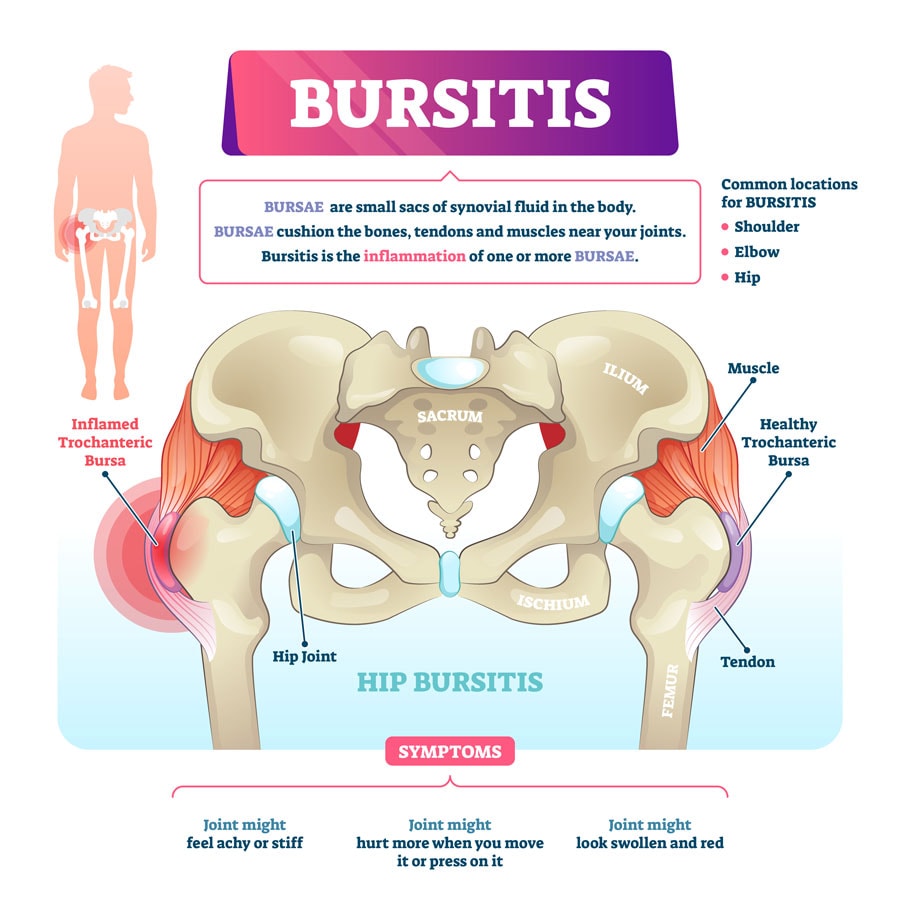 Bursitis (bur-SY-tis)is a painful condition resulting from inflammation of the bursae (bur- See), small sacs of synovial fluid that cushion bones, tendons, and muscles at the joints. The bursae promote smooth, friction-less movement. Though bursitis is not a life-threatening condition, it is uncomfortable or painful and may impede daily functioning. Treatment involves resting the affected area and applying topical medication for inflammation and pain. In severe cases, patients may require surgery.
Bursitis (bur-SY-tis)is a painful condition resulting from inflammation of the bursae (bur- See), small sacs of synovial fluid that cushion bones, tendons, and muscles at the joints. The bursae promote smooth, friction-less movement. Though bursitis is not a life-threatening condition, it is uncomfortable or painful and may impede daily functioning. Treatment involves resting the affected area and applying topical medication for inflammation and pain. In severe cases, patients may require surgery.
The Most Common Locations for Bursitis
Those with bursitis feel pain at the site of the inflammation, most often in the shoulder, hip, or elbow. The condition may also affect the knees, heels, and shins. The pain in these areas is usually a dull ache that worsens with movement. Over-the-counter painkillers can help relieve the pain, which in most cases takes a few weeks to resolve.
Treatment for Bursitis
Bursitis generally gets better on its own. Conservative measures, such as rest, ice, and taking a pain reliever, can relieve discomfort.
If conservative measures don’t work, you might require…
- Medication – If the inflammation in your bursa is caused by an infection, your doctor might prescribe an antibiotic.
Therapy. Physical therapy or exercises can strengthen the muscles in the affected area to ease pain and prevent a recurrence. - Injections – A corticosteroid drug injected into the bursa can relieve pain and inflammation in your shoulder or hip. This treatment generally works quickly and, in many cases, one injection is all you need.
- Assistive Device – Temporary use of a walking cane or another device will help relieve pressure on the affected area.
- Surgery – Sometimes an inflamed bursa must be surgically drained, but only rarely is the surgical removal of the affected bursa necessary.
Causes for Bursitis
Bursitis is common in adults, especially after age 40.
It’s usually caused by repeated pressure on an area or by using a joint too much. High-risk activities include gardening, raking, carpentry, shoveling, painting, scrubbing, tennis, golf, skiing, and throwing. You can also get bursitis by sitting or standing the wrong way for a long time at work or home, or by not stretching enough before you exercise. A sudden injury can sometimes cause bursitis. As you age, your tendons aren’t able to handle stress as well. They’re less elastic and easier to tear.
How To Reduce Your Risk Of Getting Bursitis
Reduce repetitive motions, such as a pitcher throwing a baseball over and over, which commonly causes bursitis. Also, spending time in positions that put pressure on part of your body, such as kneeling, can cause a flare-up. Occasionally, a sudden injury or infection can cause bursitis. Use kneeling pads to reduce the pressure while kneeling. Bend your knees when you lift heavy items to put less stress on the bursae in your hips. Use a dolly or a wheeled cart instead of carrying heavy loads that put stress on the bursae in the shoulders. And warm-up and stretch before strenuous activities to protect your joints from injury.
For persistent pain that is interfering with your daily activities, see a rheumatologist to make the correct diagnosis and begin the proper treatment.
We Treat Patients With Shoulder, Bursitis Hip, and Elbow Pain…
Shoulder pain can occur suddenly with an injury, such as a fall on the shoulder. However, many people develop shoulder pain without any injury (non-traumatic shoulder pain). There are several common causes of non-traumatic shoulder pain, and the risk for these problems increases with age. The most common causes are tendonitis, rotator cuff tear, bursitis, arthritis and frozen shoulder.
> Learn More
Contact Us (859-331-3100) For More Information to Request an Appointment
—
 About Tristate Arthritis and Rheumatology
About Tristate Arthritis and Rheumatology
Tristate Arthritis and Rheumatology is first and largest Rheumatology practice in the Northern Kentucky area. Founded by Dr. Arthur Kunath in 1986, our rheumatology practice now consists of six doctors who are board certified in both Internal Medicine and Rheumatology and a Physician Assistant. Patients see one doctor (except in emergencies), thereby assuring continuity of care and an individualized doctor-patient atmosphere giving the physician the ability to establish personalized and detailed relationships. Our doctors have received numerous awards, including being listed as “Top Doctors” in Cincinnati Magazine, receiving the Patient’s Choice Award, the Most Compassionate Doctor Award, and the American College of Rheumatology’s “My Doc Rocks” award.
>> Learn More



